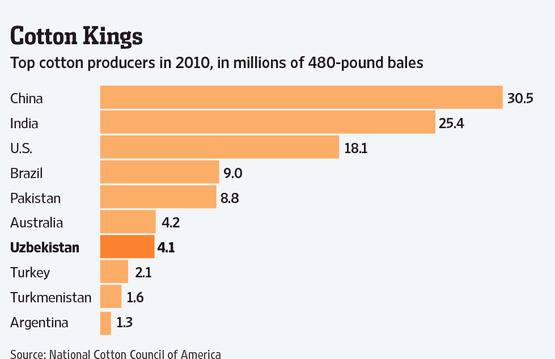|
Broad market euphoria over Europe¡¯s plan to conquer its 2-year-old debt crisis, robust U.S. export sales and a cut ¡ª subsequently disputed ¡ª in Pakistan¡¯s crop prospects have combined to drive cotton futures to a six-week high. Spot December, unable to generate follow-through from the prior week¡¯s downside breakout, advanced 746 points for the week ended Thursday to close at 104.32 cents and finish back above its 50-day moving average. December, which closed up the 400-point daily limit at the end of the period, rose five sessions in a row and settled at its highest finish since Sept. 20. March gained 689 points to close at 102.31 cents. Cash trading quickened to a marketing year high of 13,400 bales on The Seam¡¯s grower-to-business exchange, up from 3,467 bales the previous week. Prices averaged 100.07 cents, up from 98.66 cents, with premiums up 133 points to 45.73 cents over loan redemption rates of 54.44 cents. Business-to-business sales increased to 26,093 bales, also a crop year high. The cotton changed hands at prices averaging 87.96 cents, down from 91.58 cents, reflecting a drop to 38.56 cents from 41.82 cents over average redemption rates of 49.40 cents. Net U.S. export sales posted a marketing year high, rising to 386,000 running bales during the week ended Oct. 20 from just 60,100 bales the week before. Pima sales accounted for 900 bales. A whopping net 396,700 bales went to China, which accounted for 92 percent of gross upland sales of 432,300 bales. Light purchases by Turkey and Taiwan also helped to more than offset upland cancellations of 47,300 bales, mainly by Mexico, Vietnam, Thailand and South Korea. Commitments climbed to 7.502 million running bales, about 15 percent of which have been shipped. Bookings trailed year-ago commitments by 3.329 million bales. Shipments remained light at 75,200 running bales, nudging exports for the season to 1.095 million bales. The lag behind exports a year ago widened to 809,000 bales. Shipments have reached less than 10 percent of the USDA forecast, against about 14 percent of final exports a year ago. Pakistan has cut its cotton crop forecast to 12.22 million bales (170 kilos or 375 pounds), down nearly 800,000 bales or about 6 percent from earlier projections, Reuters reported, citing a government textile body. The world¡¯s fourth-largest cotton producer had hoped for a record crop of about 15 million bales before monsoon floods hit its second-largest cotton province of Sindh in August and September. The estimate by the Cotton Crop Assessment Committee of the Ministry of Textiles drew an immediate response from the All Pakistan Textile Mills Association, Pakistan Yarn Merchants Association, Karachi Cotton Association and Pakistan Cotton Ginners Association. They contended the CCAC damage estimates were exaggerated. The latest USDA estimates put Pakistan¡¯s crop at 10 million 480-pound bales, a 14 percent increase from its previous flood-devastated output, and imports at 1.5 million bales, up 3 percent from last season. On the U.S. crop scene, harvesting advanced 10 percentage points to 44 percent complete during the week ended Oct. 23, USDA reported. This was five points behind a year ago but eight points ahead of average. Boll opening expanded a point to 95 percent, behind 97 percent a year ago but up from the five-year average of 93 percent. Crop ratings declined, with good to excellent down a point to 29 percent, fair down two points to 27 percent and poor to very poor up three points to 44 percent. A year ago, the crop rated 53 percent good to excellent, 31 percent fair and 16 percent poor to very poor. Futures drew support early in the week from encouraging data from China. Manufacturing in the world¡¯s second-largest economy expanded moderately after three months of contraction, easing fears that China¡¯s economy might be headed for a hard landing. China, the world¡¯s largest cotton importer and consumer, is forecast by USDA to import 14 million bales this season, up 17 percent from a year earlier and the second highest on record. This would be about 38 percent of world imports forecast at 36.5 million bales. How China implements its cotton ¡°macro-control¡± policies will determine its actual 2011-12 imports, USDA analysts say. China has established a program to purchase cotton for its national reserve at a floor price of 19,800 yuan per metric ton or the equivalent of about 140 cents per pound, considered likely to be above the world market-clearing level. The reserve auctions thus far have focused on domestic cotton and were reported to have reached cumulative acquisitions of 23,250 metric tons (about 106,800 bales). Reserve buying has offered only limited and indirect support to the international market, trade analysts say. Meanwhile, Chinese mills, have bought from various origins ¡ª including the big U.S. purchase ¡ª while seeking to fill the remainder of existing quotas and have the cotton arrive before they expire at the end of the calendar year. It is not clear how Beijing will manage import quotas in combination with reserve purchases. An objective is to support prices to farmers, but Beijing has been less specific about rebuilding national reserve stocks. The USDA¡¯s projected increase in imports would allow China to rebuild total ending stocks to about 3.5 months of mill use. This would be sufficient to meet consumption and pipeline requirements at the beginning of 2012-13. To reach USDA¡¯s import forecast, China will need to release some additional import quotas beyond the customary tariff-rated quota of 894,000 tons (about 4.1 million bales) for 2012. And if the government wants to retain more cotton in the national reserve, USDA analysts say, it will need to increase import quotas commensurate with its stock objectives. lubbockonline.com
|
|
Europe deal helps power cotton futures to six-week high
Updated: 2011-11-4 Source: lubbockonline.com

Recommended News
Photo Gallery
Most Popular



